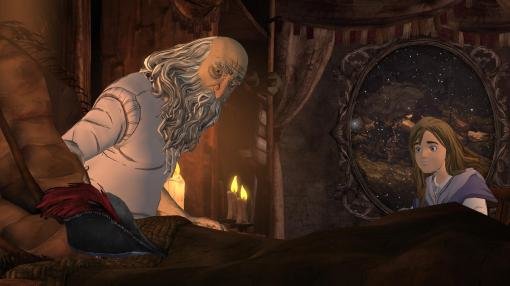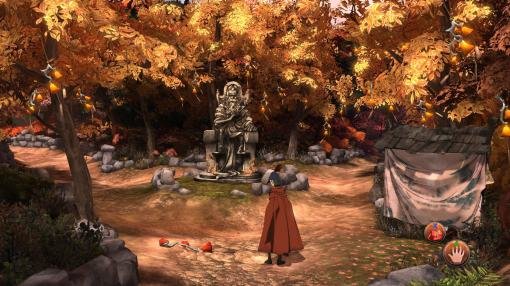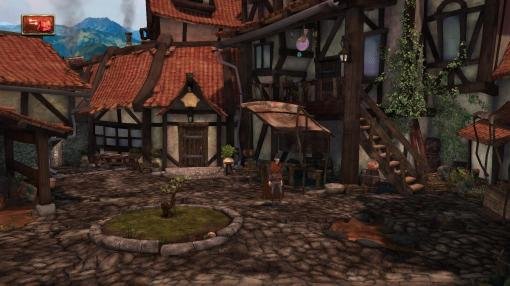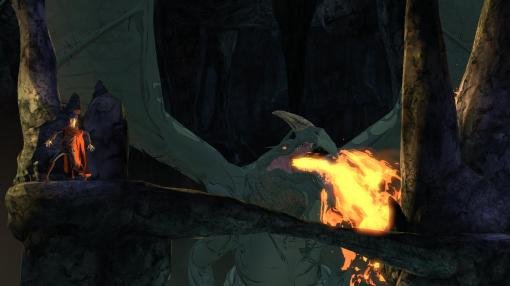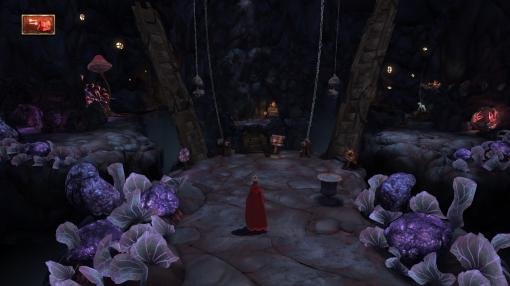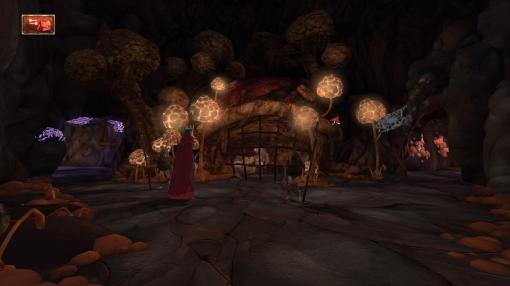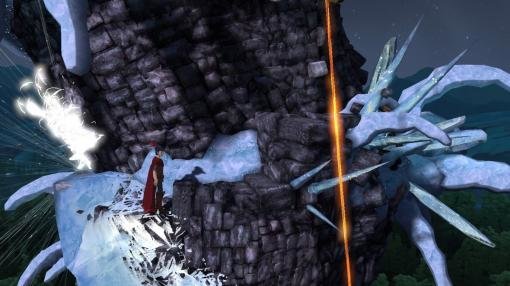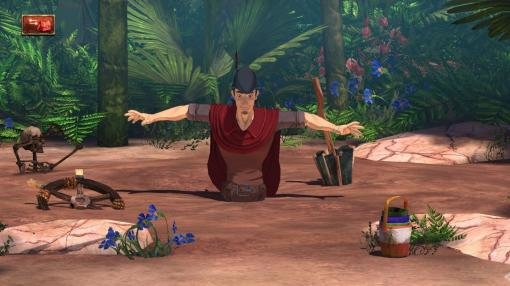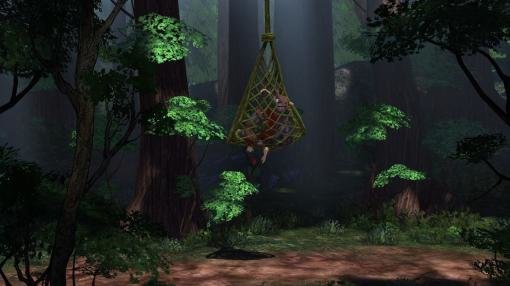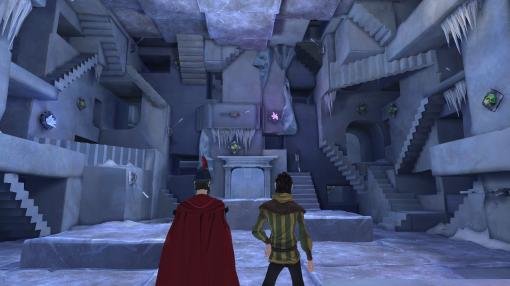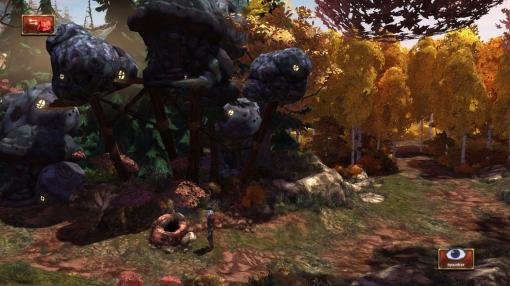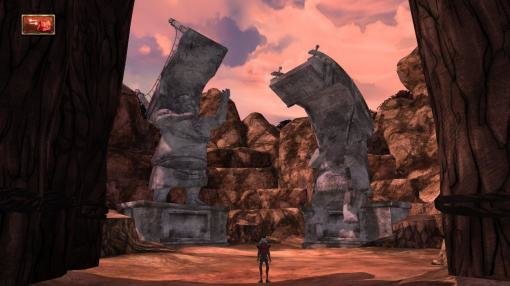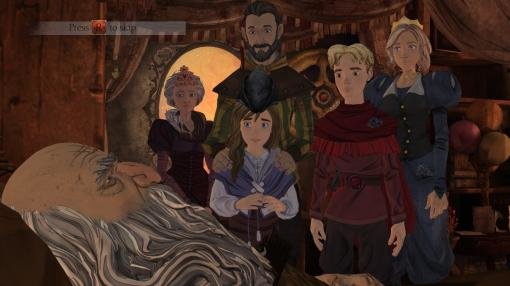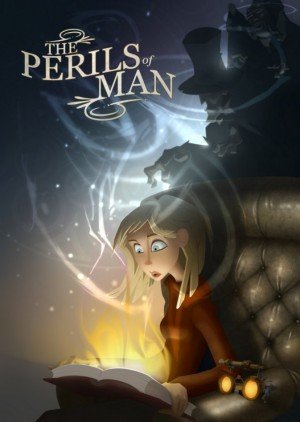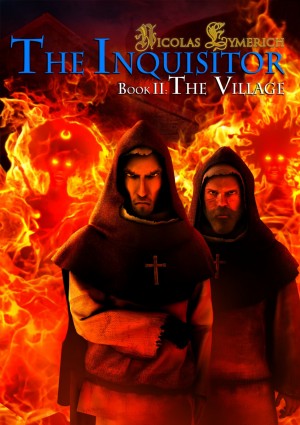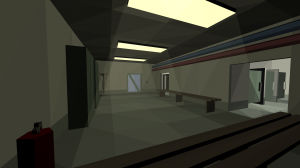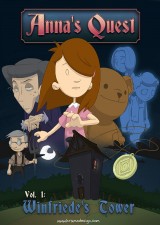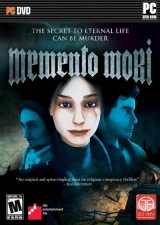Review for King’s Quest

Take me straight to Chapter 5!
Chapter 1 - A Knight to Remember
The King’s Quest fantasy series, created by Roberta Williams of Sierra On-Line, originally launched in the early 1980s. The franchise continually pushed the technological envelope in its day, and was hugely popular among adventure gamers over the years, but came to a full stop after the eighth game, Mask of Eternity, abandoned its beloved cast of characters in favor of action-oriented gameplay with real-time combat sequences. Now, almost twenty years later, the series is being rebooted under a newly-revived Sierra label, as The Odd Gentlemen refocus our attention on how a knight wannabe named Graham saved the sumptuously colorful, quirky kingdom of Daventry. And what a return it is. Whether for longtime series fans or total newcomers to King’s Quest, Chapter 1 – A Knight to Remember is an enjoyable 3D romp filled with witty dialog, superb voice-overs, twisty conundrums, and entertaining choices that affect its outlandish characters.
Our story begins as the elderly King Graham, having recently fallen ill, chats with his young granddaughter Gwendolyn, who has traveled with her family to Daventry out of concern for his failing health. Gwendolyn loves to hear tales of her grandfather’s exploits. He starts by describing a past quest where he was tasked with finding a magic mirror guarded by a dragon. As the flashback begins, you control a much younger Graham, who attempts to outwit the dragon in a subterranean realm littered with traps, skeletons, bell-pulls, and mattresses.
Young Graham is not of royal blood, so he must earn his way to his eventual kingship. He sports a stylized figure – long-limbed and bow-legged, with overlarge ears and a red-tinged nose. His face is not quite handsome (perhaps good looks will come with maturity) but he has an earnest, appealing manner. He wears old-fashioned clothes, a cape with many pockets, and of course a cap with a red feather.
Expertly animated, Graham runs with an ungainly gait, his cape rippling behind him. He sometimes launches into paroxysms of enthusiasm, leaping into dramatic poses and shouting bizarre questions that show the odd way his mind works. Cutscenes bring close-ups of his face expressing determination, perplexity, awe, annoyance, joy, fear and discouragement. As the game progresses, Graham’s words and actions reveal a young man gaining in confidence, skill and worldly knowledge, and the animations make it that much easier to empathize with him. It’s been a long time since I understood a character in an adventure game this deeply after a mere seven hours (so far) in his company.
The environments in A Knight to Remember are displayed in cel-shaded 3D that creates a hand-painted effect. Locations consist of the village of Daventry, brief glimpses of the castle, and a theater interspersed between fields, mountains and caves. Rustic rooms are furnished with tapestries, carved wooden furniture, curtains with decorative borders, and colorful banners. Unexpectedly, realistic textures are used with stylized shapes. I would have thought this might give the environments an inconsistent quality. But it’s accomplished with such a deft touch that everything works beautifully together – it’s magical yet naturalistic.
Outdoor locations feature fall foliage in many shades of gold, mauve, coral and copper. Each scene is spectacularly detailed, with layers of rock formations, trees, weathered hills, leafy ferns, gnarled roots or moss strewn with fallen leaves. Skies and distant mountains have a watercolor-wash effect, with blues, greys and purples bleeding together. A gentle light embraces the scenery, casting lifelike shadows. Ambient animations enliven the world. These combine traditional touches such as falling leaves, fluttering butterflies, and birds on the wing with unconventional ambiance-builders: shrubbery that trembles and roars, a unicorn-like creature feasting on a large steak, and two castle guards galloping about, one riding the other piggyback-style.
Graham competes in a tournament whose winner will become an official Knight of Daventry. He squares off against four other hopefuls: Whisper the fleet of foot; the diminutive but influential Manny; tall, silvery and silent Achaka; and Acorn, a hulking brute with a rodent fixation. All of the opposing knights-in-waiting have secrets (only some of which are disclosed in this first chapter), and each wears distinctive armor and a helmet so that his face is always hidden.
Up in the village, Wente the baker shows off his neverending moustaches. Amaya the blacksmith has invented “Missus Crumbler,” which destroys anything smaller than a stone tower within seconds. The Hobblepots own a magic/curiosity shop and bicker like an old married couple (which they are). These villagers represent three different philosophies: a life of compassion and cookies, a belief in taking direct action while trusting your “gut,” and the certainty that the solution to every problem lies in using your wits (and perhaps a potion or two). The townspeople’s attitudes toward Graham change in accordance with his actions in the game.
A star-studded group of actors provide voices for the animated characters. Perhaps the most prominent of this talented group are Christopher Lloyd, who gruffly voices the elderly King Graham, and Wallace Shawn, who portrays the wily Manny. Josh Keaton brings boyish exuberance and candor to the role of the young Graham. And kudos to Jean Gilpin, who delivers just the right amount of French-accented sauciness for the flamboyant bridge troll Pillare.
A Knight to Remember tells an intricate tale. The story framework of the relationship between the elderly Graham and Gwendolyn leads to a series of flashbacks from two different time periods. Events in each story layer parallel and reflect the others. For example, the opening adventure with the dragon recalls a previous skirmish with this same dreaded beast when Graham was even younger and much less experienced. The elderly Graham narrates these encounters from the viewpoint of age and perspective, with Gwendolyn commenting on and questioning his actions in the past.
This dramatic, sometimes tragic tale is lightened by the elderly Graham’s vast trove of puns ranging from clever to remarkably silly. The over-the-top characters frequently find themselves in dangerous scenarios. But just as often they trigger situations that range from absurd to absolutely ridiculous. The droll dialogs and amusing plot revelations meant that I played with a big silly grin on my face, occasionally laughing out loud.
Orchestral backgrounds support the nostalgic, olden-days atmosphere in this game. My favorite was the whimsical marching music, complete with fanfare, which accompanies Graham as he navigates the various paths. A medieval tune with plucked strings buoyed my passage through the village, and a mournful piano solo was so lovely that I felt like slapping the character that sobbed and blew his nose all the way through it. The music is clearly meant to enhance the ambiance rather than dominate, playing quietly in the background. Ambient sounds also tickle the ear, whether birds chirping, water gurgling, bells chiming, critters whimpering, or footsteps crashing.
Played from a third-person perspective, the PC version allows you to use the WASD or arrow keys, or a controller while navigating. I started the game using the keyboard, which requires quite a lot of input to keep from bumping into things. By about halfway through the first playthrough, I switched to a controller and found it significantly easier. The mouse can also be used at certain times – when accessing the inventory and during dialog choices, for instance. Fortunately, you can switch seamlessly back and forth between the controller and the keyboard/mouse, as the mouse makes it easiest to aim during light shooting sequences.
When Graham approaches a hotspot, an icon pops up at the bottom of the screen. Hotspots are not individually identified and young Graham usually doesn’t describe them, though occasionally elderly Graham adds a comment (or even a hint) about a particular object or procedure. Sometimes the hotspot indicates a predetermined action – pressing the spacebar or controller button while it’s active will cause Graham to climb part of a wall, for instance, though you’ll need to ascend the rest of it manually.
Unfortunately, the game does not allow you to click through dialogs, and since there’s no indication when new topics become available or when conversation has been exhausted, you will experience some unintended repetition. (Update: this feature was added with the launch of Chapter 2, but not retroactively to include Chapter 1.) Progress is recorded via autosave only, making it difficult to experiment with different choices without replaying the entire game from the start.
A Knight to Remember contains conundrums that will test your wits, observational skills, reflexes, and sense of humor. In addition to frequent inventory puzzles, you’ll also encounter dialog challenges and pattern sequences where, for instance, you must activate devices or make sounds in a specific order. A tough board game challenge can be played straight or – if necessary – won by finessing your opponent. There’s no pixel hunting, though twice I missed a new branch of the path until I headed in a non-obvious direction. Puzzle difficulty ranges from easy to medium; solutions are sometimes conventional, but more often they are delightfully goofy.
The most thought-provoking challenges are the choices you must make. These surface frequently – at times they are dialog choices, but they can also involve a decision as to which object to pick up or buy, or where to use an inventory item that solves multiple problems but can only be used once. These selections often take place in the village shops or relate thematically to the philosophies of the town merchants. I played the game twice to monitor the effect of the decisions I’d made. Though they don’t seem to change the overall story arc, the choices do lead to attitude changes and differing tasks for non-player characters, diverse items appearing in inventory, alternative cinematics, and even divergent dialogs and cutscenes in the elderly-Graham-and-Gwendolyn exchanges.
Quick Time Events also pop up at regular intervals. If you’ve never experienced QTEs before, this is a good game to serve as an introduction, because the frequent autosaves and short sequences mean that they are doable, even for someone (like me) without fast reflexes. The shame of QTEs, of course, is that it’s impossible to admire the environments you’re passing through or the animations of the character you’re controlling because you’re focused on symbols on-screen that must be responded to instantly. Having fewer QTEs would have improved the game.
Graham has a bow and arrows, though they don’t show up in inventory. Instead they appear whenever a shooting sequence occurs. The most difficult timed event is a skirmish with multiple targets which took me ten attempts before I succeeded. Other timed challenges include a race where you avoid mobile barriers, a zany entrapment exercise, and knowing when and where to hide to avoid being eaten.
Speaking of being a meal, it is possible to die in this game. Annihilation came in many forms in the classic King’s Quest series – in King’s Quest I: Quest for the Crown I experienced death by alligator, witch and water in just the first 15 minutes of gameplay. Casualties are much less frequent in A Knight to Remember, but they are still a part of the adventure: among other agents of necrosis there’s a flaming dragon, angry goblins, snarling wedzels and a flying bed. Thankfully, after the squashing, incinerating, etc. event, elderly Graham and Gwendolyn discuss what went wrong and you’re taken back to the moment before disaster.
As this debut chapter drew to a close, I was surprised at how effectively it had pulled me in. I didn’t expect hilarity combined so expertly with tenderness and pathos. Granted, it gave me a thrill just to see “Sierra” and “King’s Quest” once again splashed across the screen. But this game doesn’t just revive the King’s Quest brand, it reimagines the story and deepens the character of Graham while providing activities that, despite something of an overreliance on QTEs, are as wackily engaging as they are varied. This first installment in the new King’s Quest saga rounds out its outstanding production values with an ending that satisfies, then tantalizes. Let’s hope that Chapter 2, slated to enter the fray later this year, continues to carry aloft the high standard achieved by A Knight to Remember.
Chapter 2 - Rubble Without a Cause
It’s a dark and stormy night in the Kingdom of Daventry, and thunder has awakened Gwendolyn, who scurries down to her grandfather’s room for reassurance. Her cousin Gart soon joins them and the children beg King Graham for another story, and he tells of his second quest using the magic mirror that places the player directly into the heart of his past adventures.
The tale in Rubble Without a Cause begins as young Graham, who has newly ascended to the throne, realizes that it’s harder to rule a kingdom than it is to gain one. Taking a break from some weighty addendum dilemmas, the king drifts alone in the pouring rain into the village, only to discover that goblins are seizing anyone they can catch. Unable to defeat them, Graham finds himself a prisoner deep underground in the goblin realm. The goblins aren’t the most empathetic of jailers; the villagers are slowly starving and succumbing to disease in their cages. Graham, who is released from his cell every day to perform menial chores, must figure out how to heal, feed, and free all or at least some of his captive subjects.
Our hero is soon weakened with hunger himself; his nose and cheeks aren’t as rosy or his expression as innocent as when he was a knight-wannabe, and stubble is emerging on his chin. Wente and Bramble the bakers, Amaya the blacksmith, and the Hobblepots are also prisoners of the goblins. Their life philosophies are sorely tried in prison, causing the kindly Wente to consider violence, the tricksy Hobblepots to reveal hidden compassion and athleticism, and the feisty Amaya to take an unnaturally passive role in the face of danger. Voice-overs continue to be excellent and the writing is lively and sharp. The pun factor from Chapter 1 has been toned down (though it isn’t entirely absent). Some of the funniest lines in the game occur if you wait outside the Hobblepots’ cell and listen to their attempts to make the best of their freaky situation.
The Merchant of Miracles is also rotting in the goblins’ prison, but he takes advantage of the situation in order to complicate Graham’s efforts and enrich himself with valuable goods for sale (old habits die hard). New non-speaking (or at least unintelligible) goblin characters are introduced – since they don’t have faces, they are distinguished by their hats or weapons or repeated actions. The king of the goblins is particularly memorable, with his white beard, boulder-shod feet, and rear wheel.
I am always wary of games that take place primarily underground since the environments tend to be dark, dull, and repetitive. Thankfully, that is not at all the case in Rubble Without a Cause. The goblin caves and tunnels are festooned with florescent crystals, coral-like growths and strange fungi. Occasional animations include twinkling lights, dust motes, and the movements of the guards. The goblins, in addition to their dungeons and wallpapered bedrooms, have constructed a theater, a library (I had no idea that goblins like to read – or to be read to), a throne room, and a walled-in garden. Exploring all these places provides a glimpse into goblin culture and an explanation for their fascination with certain objects like mattresses and glass slippers.
Gameplay in Chapter 2 is more traditional than in the first episode; Quick Time Events have been dropped entirely, as have the shooting sequences, and the only seemingly timed challenge turns out to be more about efficiency than moving quickly. A significant improvement: you can now skip cutscenes and dialogs by pressing a button or key. Graham can still die, though death is rare. There are quite a few inventory-based challenges which are rather clever, with items used unexpectedly and seeming solutions leading to startling (and sometimes humorous) results. There’s also a music puzzle that can be solved visually, a blackout maze with glowing lizards providing help and hindrance, and a column-hopping pattern. I welcomed the variety of conundrums and the lack of reflex-based challenges. Overall puzzle difficulty is about average – I was only once stuck for an extensive period when I repeatedly missed an item hotspot.
The diciest part of this game is keeping all the prisoners alive and safe before an escape can be managed. This requires careful consideration when using food, coins, and sleep (sleeping advances the story to the next day). In my first playthrough, which took almost five hours, I lost two of the villagers plus Mr. Fancycakes almost immediately. The second time around, which took three hours, I sacrificed Mr. F but managed to keep all the villagers healthy until late in the game when, despite careful planning, I lost one. (Apparently desserts don’t qualify as food under the strict Daventry Nutritional Guidelines.) I know there’s a way to “save” all the villagers – there’s an achievement for it – but I haven’t yet figured out how to do it. Losing people inevitably tugs at the player’s heartstrings, right up until the chapter’s finale.
The story ends with a twist and (for me) a sense of satisfaction, plus a nip of a teaser for Chapter 3. I was surprised that decisions made in the first episode didn’t significantly influence a lot in the second one – the only carry-overs seem to be brief references to earlier events in the dialog. As in the previous episode, choices made while playing young Graham’s adventure affect the events in the elderly Graham/Gart/Gwendolyn ending.
Rubble Without a Cause is less of a comedic romp than A Knight to Remember, delving into the dark lining that underscores the silver clouds of the first chapter. Times when there are only bad choices bring anguish, and King Graham – with his brilliant-to-nutty improvisations – runs smack into the wall of his own limitations. Still, even in the dungeons there are chuckle-worthy moments, instances of triumph, and places of peculiar beauty. Given the playful yet thought-provoking path carved out so far, I’m expecting the next King’s Quest installment to continue to jolt and beguile me.
Chapter 3 - Once Upon a Climb
Flashing back to the Graham we met in Chapters 1 and 2 with a “catch-up” narration by the elderly king, King’s Quest: Chapter 3 – Once Upon a Climb goes on to show the young man settled into his royal role and gaining in maturity. Lately he’s been walking with a swagger; his conversation is more measured and confident, and he holds himself proudly. He’s handsome and buff, having apparently spent hours at the Daventry Gym in an attempt to be a better king. Or, at least, to look like one.
The dark, desperate hours in Rubble Without a Cause ‘s goblin kingdom are but a fading memory, and this new episode revives the lighthearted atmosphere of A Knight to Remember. The kingdom and Graham are getting along swimmingly except for one not-so-minor detail: Graham’s subjects would like him to find a princess, marry her, and produce an heir. Graham isn’t opposed to the idea, but an implementation strategy is clearly lacking. The magic mirror (acquired in Chapter 1) hastens the matter by revealing that the woman fated to be Graham’s wife is trapped at the top of a tower, waiting to be rescued. Our hero, who loves adventure, is not at all averse to adventuring for the sake of love, so off he goes to the Enchanted Isles to meet his future queen.
Various hindrances litter his path, of course – including scaling the tower which, from a distance, looks like a curvy, crooked stone snake. Since random steps appear on the exterior as Graham approaches, climbing the tower is almost child’s play for any rock-jock. But when he makes it to the top, Graham discovers the real obstacle to his courtship plans: two princesses are there, both trapped. And both are prospective mates. Which one is Graham’s true love? Only time (and player choices) will tell. In effect, gamers are hornswoggled into the role of King Graham’s matchmaker.
The two potential queens exhibit characteristics that are similar to Graham’s. For instance, one princess is fond of puns and puzzles; the other craves challenging adventure quests and indulges in “uncontrollable outbursts of excitement.” It seems that, from the minute you meet these two ladies, everything you have Graham do or say – and the order in which he does or says it – could potentially sway the decision one way or the other. This is slightly unnerving, but also rather delightful.
The truth is, when you reach the chapter’s ending Graham will have fallen in love, but how the choice is made isn’t exactly apparent. I used different selections and decisions for my second playthrough, and still ended up with the same princess. The final screen does give a hint as to what’s most important; maybe I should have taken it more to heart.
Gameplay is varied and of easy-to-medium difficulty, involving such contraptions as tone patterns on a lute, sliding blocks, and a log-and-debris construction challenge. The initial puzzle, which cleverly exploits the passage of time between the three episodes so far, is particularly satisfying. You will also test your reflexes while shooting a bow and arrow, clear a path as you fall down a hill, dance formally to a QTE-directed rhythm, and even indulge in a brief stealth sequence. Plus there are many choices to consider – among them, which princess to talk to and when, which conversational options to select, which items to pick up first, which objects to save from falling when the tower totters, and which shop to enter. At one point the game gives you the chance to lower a bridge via a tricky rotation puzzle or, instead, opt for an absurdly easy test of your strength.
There’s also an interesting social card game, meant to reveal character, which you play with the two princesses called “Moral Quarrel.” Here you read outrageous storybook scenarios, select one of two possibilities for resolving the situation, and then find out how the princesses would have answered. You can pick what you (personally) would do in each given scenario, revealing which princess is most like YOU. Or you can choose as you think Graham would, showing which princess is most like HIM. Of course, there are surprises along the way.
It’s possible to die on occasion, but you are returned to a location close to where you slipped up. I repeatedly entered the sweet hereafter during the final tower-climbing-and-leaping extravaganza, mostly because it’s prolonged, requires fast reflexes, and the autosave points are further apart than in earlier action sequences. At first I used the keyboard controls (I was able to play Chapter 2 entirely with the keyboard, so I had gotten into the habit), and I found that the spacebar wasn’t always responsive during leaping. The “enter” key was more reliable, but when I finally wised up and switched to a controller, I beat the frosty tower spectacular on the third go-round. Overall, it took me six hours to finish Chapter 3, one hour of which was spent scaling (well, mostly flubbing) the final tower. I made it through the second playthrough in two and a half hours.
Though Once Upon a Climb contains traditional puzzles and mostly easy action challenges, the episode is essentially story-focused. One indication of this: the sheer amount of time spent on close-ups of the characters’ faces as they chat, argue, or react to events. It becomes patently clear that Graham is in over his head, and is probably better able to handle a fire-breathing dragon or a goblin army than two lovely young women in a rustic and intimate space. There are also clever villains lurking, one close-at-hand, and others preparing to unleash their knavery from afar. Characters from previous chapters resurface at unexpected moments. The story unfolds entertainingly, switching seamlessly between well-animated cutscenes, dialogs, and sensibly-integrated gameplay. Backstory revelations come at unforeseen moments and are highly rewarding. By the end, I realized that this is the closest I’ve come to the sensation of “playing” an animated movie.
The zestful writing and skillful voice-overs are continuing strengths for the series. Warning: you will once again find yourself in egregious pun territory. Rousing instrumentals, swelling romantic strings, and manic stomping music are attuned to the game’s various settings and plot diversions. Occasionally a tune recalls the soundtrack from previous popular songs: a little bit of rumba nonsense evokes Man of La Mancha, for instance, and there’s a nostalgic return to the “Girl in the Tower” music from King’s Quest VI.
The graphics are gorgeous. The lovely watercolor skies crowning Daventry make a return, as do the rocky cliffs, shadow-reflective streams, and thick woodlands. The medieval tower interior includes a large fireplace, collections of books, an easel painting of a giant avocado, and elaborate draperies (color-coded to match the princesses’ differing tastes). Picturesque sunsets turn the sky gold and the mountains purple. Graham finds a temporary portal leading out of the tower, so you will briefly visit the town of Daventry, a tropical beach, and the threatening forest of Avalon. Landscape scenes are enlivened by rippling waves, birds on the wing, struggling frogs and mischievous squirrels.
In many ways, this is my favorite King’s Quest chapter so far. The personalities of the two princesses are an intriguing contrast and the tension between the people trapped together – and the ugly force keeping them there – is expertly maintained. Watching Graham handle this odd situation, with the pun-filled dialogs that result, had me chuckling. The puzzles suit the story, and the timed sequences, though too frequent for my personal taste, are manageable – especially once I’d gone back to using the controller. The ending is a heart-in-mouth dénouement, followed by a hint of the forces to be reckoned with later on. Once Upon a Climb is an ascent to remember. Can it be topped in Chapter 4?
Chapter 4 - Snow Place Like Home
As Snow Place Like Home opens, King Graham and his wife sleep fitfully while their newborn twins, Alexander and Rosella, tackle what newborns do best – crying in the middle of the night. His turn to tend to them, Graham sings a lullaby to comfort Alexander while navigating an obstacle course of toys, cradles and baby bottles, among other parental tasks. (Choices you made in the previous episode mean that the king is now married either to Neese or to Vee.) The domestic happiness of the introduction doesn’t last long, however, because the night suddenly turns violent when an enemy breaks into the castle and kidnaps one of the babies.
And so Graham descends into a maelstrom of fury and despair, ignoring the stacks of Daventry legal minutiae that pile up while searching for his son. Then, almost two decades later, Alexander miraculously returns, bearing a name that will be familiar to anyone who has played King’s Quest III: To Heir is Human. The young man’s acceptance back into the family is joyous and immediate, but his reactions to Daventry’s traditions and (let’s be honest) oddities show that reintegration will not be accomplished with a mere snap of a finger.
Once the past sequences end, we find King Graham in the current day, looking increasingly frail and writing letters to all his closest relatives. Something is afoot, and his advisors have urged the king to mop up his affairs. Conflict increases during a royal dinner that ends in acrimony. Young Gwendolyn is mystified by the obnoxious way her cousin Gart is treating her. The elderly Graham responds by telling a story – once again via the magic mirror – about family tensions shortly after being reunited, when his children were 18 years old and the royals left Daventry on vacation.
During the flashback journey by wagon, it becomes clear that the rail-thin, awkward Alexander is insecure and rebellious. He knows he is supposed to take over the kingdom someday from his father, and he isn't sure he'll be up to (or that he even wants) the job. Rosella is blonde, chipper, and speaks with a growly voice. She understands her father to a “T” and can cheer him up or provoke him with a mere word or two. Voice-overs continue to be compelling, particularly that of Graham in his new middle-aged, lushly bearded incarnation as well as in his latter-day, grizzled phase.
As the Daventry foursome approach the tropical resort chosen for their vacation (the same tower that once imprisoned Graham and his wife-to-be) they realize that it has morphed into an Ice Palace. Populated by frozen hotel staffers, it’s also hosted by a svelte, antlered Sphinx. The Sphinx is clearly enjoying herself as she rolls out the “L” word. Yes, it seems that part of the fun of this ice resort is its “labyrinth” theme. But relax, you won’t find a traditional maze here. Yes, a twisty, purple path winds its way throughout the grounds, however you’ll mostly encounter a linear series of puzzle rooms. You can fail repeatedly and a wrong move will freeze you and force you to restart. But hey – at least being lost for long stretches isn’t on the menu.
Of course there’s more here than meets the eye, including multiple physical dangers and a devastating encounter with the past. Graham and Alexander start the labyrinth together. As they address each conundrum, they are also working out their personality conflicts, dealing with dashed expectations, and realizing how differently they think and feel. This is important, not only because it’s a clever (and sometimes hilarious) merging of character, backstory and brain-busting, but also because it enlivens the monochromatic grey and white visuals.
The puzzle mechanisms are slightly different in each setting, and often you will work from a top-down perspective. You’ll experiment with tiles (including sliding ones), pressure-plate crystals, flippable cubes, deadly wedzels, a tricksy board game, and a three-tiered, angled collision extravaganza. Sometimes Graham and another family member cooperate to beat a conundrum. Quick Time Events are rare, brief and whimsical. My favorite challenges were near the end: the riddles and the mini-game chambers. Partly these last two seemed easier, but they were also more colorful. You could feast your eyes on varied paraphernalia and manipulate items other than blocks, statues and tiles.
The brain-teasers start out easy, but a few of the latter rooms are wickedly difficult. It makes sense that a game harkening back to past King’s Quests would contain tough puzzles (actually, it would be surprising if some serious headscratchers didn’t surface at some point). And hard-hitting conundrums in the penultimate episode suit the series’ overall pace better than if they had been introduced too early or shoved into the final episode. When Chapter 5’s inevitable drama fires up and the tale finally reaches its climax, I hope it doesn’t come to a screeching halt for a sliding tile sequence. (Or labyrinth.) Still, Snow Place Like Home at times feels like it is just puzzle after puzzle. I was filled to the brim about the same point Alexander expressed his own “enough already” doubts. Since I am about as mature as a late adolescent, I responded as he did and cheated (though in a much less magical way) on a couple of the hardest challenges. At least I didn’t have to explain my lack of perseverance to my embarrassingly enthusiastic father.
Despite this chapter’s grave themes, there’s a lot of comedic writing in Snow Place Like Home, which brightens things up. Punning is still in full force, especially in the conversations between the elderly Graham and young Gwendolyn following a death/failure. Some of these witticisms are so outrageous they whisk away the agony of defeat. I heard tons of puns. In fact, I died so often that I suspect I wiped out the elderly Graham’s quip stock – towards the end, he quieted down and instead Gwendolyn began questioning my sanity and competence.
It’s hard to give an estimate of this episode’s length. It’s so puzzle-heavy that the speed with which you get through will depend on your skills. It took me seven hours, but I could see a champion solver finishing in half that time. Or maybe even less.
I expected the fourth King’s Quest chapter to be dark and serious, forming a contrast to the blithe goings-on in chapter three. So the themes of anger, disappointment and the power of evil didn’t surprise me. What did throw me for a bit of a loop was the gameplay emphasis. Each episode so far has spotlighted a different type of challenge – lots of QTEs in A Knight to Remember, resource management in Rubble Without a Cause, frequent choice-based dilemmas in Once Upon a Climb, followed by – as it turned out – an intense series of logic puzzles in this most recent offering. Snow Place Like Home reaches its defining, ghastly moment in a sparkling but confounding cinematic. And then it ends with a hint of what’s up (or maybe down) in the finale. The suspense is killing me. I hope it persists.
Chapter 5 - The Good Knight
In King’s Quest Chapter 5: The Good Knight, Gwendolyn overhears King Graham negotiating with the magic mirror for a chance to have one, last epic adventure. Or even a tiny, trivial pursuit. Anything, as long as it gets him out of his bed and back into action. When the king and his granddaughter – for the first time – openly confront the fact that he is dying, Graham returns to the magic mirror to replay one of his many quests. He hopes that re-inhabiting his memories will bring Gwendolyn some comfort, teach her another life lesson, and help her to understand the origin of his recent, devastating illness.
This time the mirror reveals Graham as an elderly hero, still eager to improve his kingdom, solve mind-boggling puzzles, and defeat any villain idiotic enough to cross his path. Graham-in-the-mirror now has a wrinkled face and a long white beard. His red cape is gone, but his hat, with a rather frayed red feather, still perches atop his head. His joints are stiff, and he runs lumberingly. As he gingerly climbs a ladder or down a set of stone steps, he stumbles and has to catch himself.
Daventry has also changed. Near the castle the wild bushes, thorns and wildlife are gone. Instead a rose garden surrounds a charming gazebo, with convenient benches where the king can stop and rest. The present-day Graham’s memory is failing, and that affects what’s visible in the mirror. Parts of the landscape beyond the castle grounds are shrouded in a white fog or alight with flame, as the king’s recollection fades and is consumed. Conversations Graham hears as he ventures forth may have actually occurred in a different time period altogether. Other details are so inaccurate that they have to be adjusted, changing Graham’s imagination via the mirror to reflect reality – accomplished by dialog reminders from Gwendolyn.
Decisions made in earlier episodes are manifest in this chapter. Here you find out whether Graham will be remembered chiefly for his bravery, his compassion, or his wisdom. When he reaches the village, past choices (or failings) steer him toward one shop that he can enter, while the others are locked. Previous decisions also spur which character(s) give advice late in the game. Only with the benefit of this hindsight, however, do the results of your earlier paths finally become clear. At the time you’re confronted with various options, it’s not always possible to project which actions or inactions will cause what results. This isn’t a problem if you are making choices without a specific outcome in mind. However, if you’ve tried to steer Graham toward a particular philosophy or endear him to a particular villager, you may find out too late that your actions didn’t turn out like you had planned.
Speaking of choices and their outcomes, this brings up a personal sore point. It has taken 15 months to release the King’s Quest episodes and, unfortunately, the computer I used to play Chapters 1, 2 and 3 went through a series of hiccups, so I had to use a different PC for Chapter 4. Since the game doesn’t synchronize saved games to alternate devices using the Steam Cloud, my choices weren’t archived in a way that allowed access on new hardware. So for the latter two chapters I had to make do with the game’s default choices. This of course will probably not be a factor for gamers who can seamlessly play through the five episodes now that they’ve all released. But I admit that, for me, the choice-driven aspect didn’t live up to its original promise.
Unlike previous episodes, The Good Knight doesn’t introduce new characters, but the voice-overs of familiar characters continue to be extremely effective. Graham revisits locales from Chapter 1 and has short encounters with most of the people from earlier episodes. But for the most part, this story hones in on the relationship between Graham and Gwendolyn and the way the king hopes to remember, overcome, and somehow fix the past. Its themes are thoughtful, somber and wistful, with fewer chuckle-inducing moments – though the conversations are not entirely pun-free. Looking back, as this chapter encourages you to do, I am amazed at how well this game wove elements from the classic King’s Quest series into its story and environments, while delving even deeper into personalities, relationships and motivations.
Graham’s memory lapses play into the puzzles in an intriguing way. A couple of these had me flummoxed until I figured out what was going on. Puzzle variety spices up this episode, much of it referencing the past: a quick line puzzle similar to those in Chapter 4, a conundrum with the music box from Chapter 2, brief retro-styled blasts from classic Sierra past with locations from King’s Quest: Quest for the Crown (where I failed to score all available points) and King’s Quest VI: Heir Today, Gone Tomorrow (where I did manage to trigger a nostalgic dance sequence). There’s a stealth-like challenge with reversed controls requiring careful maneuvering. An elaborate multi-stepped sequence early in the game has you interpreting patterns and employing inventory items. And, much to my surprise, I encountered only one easy Quick Time Event – which actually makes sense, given that Graham’s reflexes are now very slow. My favorite challenge was the final multiple-minigame puzzle sequence clearly influenced by actor Wallace Shawn (who voices Manny) and his role in the drinking game from The Princess Bride.
The music in this fifth episode is as varied as the challenges. You’ll hear sprightly orchestral melodies as you wander the pathways, and a dramatic, nostalgic theme during Graham’s agonizing struggle with his waning strength. A simple, synthesized version of “Greensleeves” plays during one flashback. And I grinned all the way through a hilarious, jazzy Broadway-like tune sung by Acorn, celebrating the crafty way of life.
It took me more than four hours to finish this chapter. For those who purchased the Season Pass, The Good Knight is the finale, though for those who bought the Complete Collection, a playable bonus epilogue has yet to release. It should be completed within the next couple of months. For those who waited out the episodic releases entirely, the first chapter is now available for free.
I played slowly through The Good Knight – mostly because I didn’t want it to end. I’ve now followed King Graham through his endearingly awkward enthusiasms, his struggles to protect Daventry’s citizens and creatures, his awe at the vivid beauty and magical wonders of his realm, his love of cunning puzzles, his highly entertaining courtship, fatherhood, and – last of all – acceptance of his own mortality. It’s difficult for me to let go of it all without choking up. The final cutscene reveals a passing of the torch that will affect Daventry’s future and a hint of doubt as to Graham’s ultimate fate. Walking so many miles in his boots has made me applaud and respect him. I’m praying that, wherever he is now, his spirit is still strong and that he won’t be going gentle into that good night.






